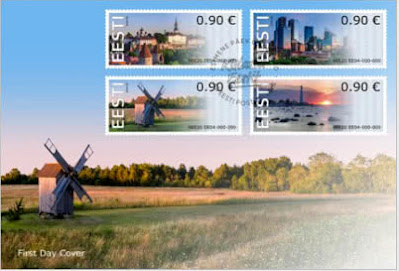1579) Franking Labels, Estonia: Omniva (formerly Eesti Post) has provided a choice of four Labels - National Standard Letter (0.90 Euro), National Maxi Letter (1.75 Euro), International Standard Letter (1.90 Euro) & International Maxi Letter (4.85 Euro): Date of Franking Labels issue: 26.11.2020:
Estonia's first franking ATM is located in Ulemiste Shopping Centre in the capital Tallinn.
The four Franking Labels (FL)There is a choice of four denominations - National Standard Letter (0.90 Euro), National Maxi Letter (1.75 Euro), International Standard Letter (1.90 Euro) and International Maxi Letter (4.85 Euro).
The stamp design on the roll repeats after every four designs. The stamps feature photographs by renowned Estonian photographers - the first three by Kaupo Kalda and the fourth one by Krister Rajandu.
Collector's strips of four different Labels each.
The First Day Cover (FDC) shows the Kukka Windmill at left (also featured on the Franking Label of 0.90 Euro). The four Franking Labels are affixed at top right.
The four Labels are cancelled with a special Handstamp/Postmark dated "26.11.2020".
The four Franking Label variants.
The first photo shows the well-known Tallinn Old Town, which has been listed as a World Heritage Site in 1997.
Adds the UNESCO publication - "TREASURES OF THE WORLD" a UNESCO publication in my personal library:
" Historic Centre (Old Town) of Tallinn, Estonia:
Tallinn is a well-preserved example of a Northern European medieval trading city. The origins of Tallinn date back to the thirteenth century, when a castle was built there by the crusading knights of the Teutonic Order. It developed into a major centre of the Hanseatic League, and its wealth is demonstrated by the opulence of the public buildings and the domestic architecture of the merchant's houses.
The lower town preserves to a remarkable extent the medieval urban fabric of narrow winding streets and fine public and burgher buildings. There are several medieval churches within the city walls. The restored Church of St. Nicholas (Niguliste) and the Church of St. Olaf (Oleviste) are both in typical basilical form, with lofty vaulting and a precise geometry of form, in what is recognised as the distinctive Tallinn School.
The most prominent feature of the town is the Toompea limestone hill. the western part is occupied by the castle, of which the tower known as Long Hermann, two bastions and the imposing walls survive on the Western, Northern and Eastern sides."
The second photo contrasts with the first one and depicts the new and modern Tallinn skyscraper quarter.
The third photo is from the photographer's gallery titled "Summer Nights in Hiiemaa" showing the Kukka Windmill in the foreground.
The fourth picture is also taken in Hiiumaa at sunset, with the Tahkuna Lighthouse in the distance.
Technical Details:
Stamp Issue Date: 26.11.2020
Printer: Walsall SecurityPrinters
Process: Offset
7) The Finno-Ugric Peoples of Europe, Estonia: The second of the two Euro Zone circulation coins to be released in 08/2021 by the Bank of Estonia




No comments:
Post a Comment